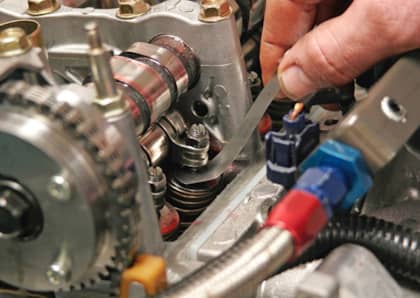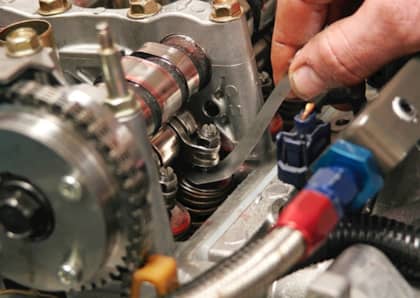15 Reasons Why the Toyota 2JZ-GTE (Still) Rules
Toyota’s Supra dates back to the late-1970s when it spun off as a high-performance version of the brand’s second-generation Celica. They called it the Celica Supra and, until it dropped its first name and was sold with the nearly indestructible 2JZ-GTE that’s good for as much as 2,000 hp, a good number of you didn’t care a lick about it.
Here are the top 15 reasons why the 2JZ-GTE’s still relevant and why, after two-and-a-half decades, you probably still can’t afford the MKIV Supra they were sold with.

1. It’s bulletproof:
The 2JZ-GTE’s solid-deck and cast-iron engine block means even you’ll have a hard time blowing one to smithereens. Double its horsepower without so much as cracking its bottom end open. Prepare it for eclipsing the 1,000hp mark with nothing more than off-the-shelf forged pistons and connecting rods.
Find out about the Duramax diesel V-8 and how to make it bulletproof.

2. Making 700whp is easy:
Did we mention how strong the 2JZ-GTE is? The recipe for more than doubling its factory rated 320hp is as straightforward as it gets: Beyond the requisite forged internals, go ahead and scrap those sequential turbos for a bigger, 64mm single one, find yourself an external wastegate and front-mount intercooler, and make sure you’ve got enough fuel for all of this with a higher-flowing pump, bigger lines, 1,000 cc/min. injectors and some sort of tunable ECU.
3. Making 2,000whp isn’t out of the question:
Nobody needs a 2,000hp Supra, but that doesn’t mean it shouldn’t be done. You’ll need a 72mm turbo or bigger, billet main caps to keep that crank in place, fatter head studs to prevent the head from lifting, bigger cams, some head porting, a few fuel pumps, 12—yes, 12—2,000 cc/min. fuel injectors and one big set of cojones.

4. Internal overkill:
But you won’t be making 2,000 hp anytime soon, which is why you appreciate the 2JZ-GTE’s forged crank with its massive main journals, dished pistons and seven heavy-duty main caps that you’ll probably never need to swap out but are easy to come by should you feel the need.
5. Details matter:
Toyota’s engineers wanted the 2JZ-GTE to last—apparently well into the twenty-first century. To do that they implemented all sorts of important things you’d never know about, like internal oil squirters that cool off the pistons’ undersides and keep them lubricated at higher engine speeds.

6. It’s hip to be square:
Those same engineers that worried about keeping the pistons cool also put a lot of thought into the rotating assembly’s geometry, implementing the elusive square-shaped layout where the diameter of its bore is the same as the length of its stroke.

7. A well-balanced beast:
Toyota’s inline layout means that whole mess of pistons and rods is naturally balanced. Unlike V-type engines, half of the 2JZ-GTE’s rotating assembly doesn’t get thrown about in opposite directions. Watch the inline six’s internals spin about and watch its front three cylinders do the opposite of the others. That even distribution of mass means the sort of polar rocking motion you’ll find in any V6 or V8 isn’t there. In other words, all of this means you can rev it higher longer, safer and smoother than anything else, and its tightly packaged design means there’s a whole lot more room underneath the hood for activities.
8. No interference here:
The 2JZ-GTE is based off of a non-interference valvetrain, which means that if, say, that timing belt slips because you decided those maintenance intervals didn’t apply to you, those valves and pistons will never get any better acquainted with one another than they already have been.
9. OEM parts that don’t break:
Speaking of timing belts, they’re typically not prone to failure so long as they’re replaced as often as Toyota says they ought to be. Even the 2JZ-GTE’s oil pump and entire cooling system are good for 1,000hp duty in stock form.

10. A case for sequential turbos:
In stock form the 2JZ-GTE is based upon two sequentially paired Hitachi turbos. While the setup is nowhere near good enough to get you the 700hp you think you need, it’s a terribly efficient design where one turbo does its job first followed by the second one at higher engine speeds. The results? Boost that you’ll notice by 1,800 rpm and that won’t quit until you want it to. And swapping in a pair of bigger, aftermarket turbos doesn’t mean you’ve got to ditch that sequential layout.

11. Because motorsports history says it rules:
Almost 25 years later and the 2JZ-GTE’s still being used by drag racers, drifters and anybody else looking for the same sort of indestructible building block that set records at Pikes Peak and the 24 Hours of Le Mans.
12. Your Lexus will thank you for it:
Got an older Lexus IS300, GS300 or SC300? With the right parts, the 2JZ-GTE is the makings for a completely bolt-in engine transplant—transmission, computer and all.

13. Secret horsepower:
For as strong as the 2JZ-GTE is, 320hp and 315lb-ft of torque doesn’t sound like a whole lot. Blame it on the horsepower-capping rules implemented in Japan during the 1990s, also known as the Gentlemen’s Agreement, that’s since been squashed but kept manufacturers from squeezing every last bit of power out of the engines they were churning out. The good news for you is that Toyota built the 2JZ-GTE to make a whole lot more than 320hp before de-tuning it, which is why bolt-ons and a simple tune can make such significant gains.

14. A sprawling aftermarket:
Few cars rival the number of cams, pistons, clutches and turbos that are available for Toyota’s 2JZ-GTE. If you want it, chances are, it exists, which means reaching that 1,000hp mark can be done using nothing but off-the-shelf goods that’ve been tested and sorted out long before you got your mitts on one of these mills.

15. You can still find one:
For as good as the 2JZ-GTE is, there’s no shortage of them. Find one under the hood of any ’93-’98 Supra Turbo or get yourself a slightly less-powerful Japanese version for even less money. There are even variants like the de-stroked 2.5L 1JZ-GTE, of which later versions have got Toyota’s take on variable valve timing and just one turbo coming off of its cylinder head.
More From Driving Line
- Guess what? There's an engine swap meet dedicated to the JZ engine that you need to see.











